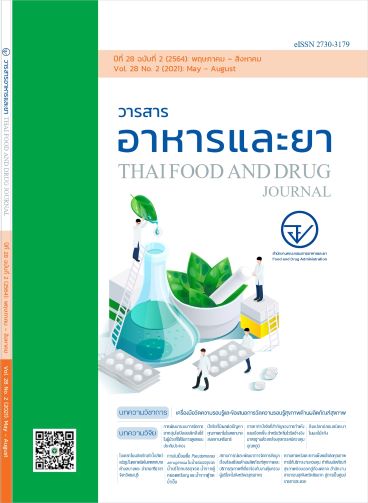สิ่งแปลกปลอมชนิดเบาในผลไม้แห้ง
Main Article Content
บทคัดย่อ
ความสำคัญ: ผลไม้แห้งเป็นผลิตภัณฑ์แปรรูปจากผลไม้ที่นำมาเพิ่มมูลค่า โดยนำมาลดความชื้นภายใต้
แสงแดดหรือนำไปอบ อาจปรุงแต่งกลิ่น สี หรือรสด้วยส่วนประกอบอื่น มีการผลิตทั้งระดับท้องถิ่นและโรงงาน
อุตสาหกรรม นอกจากผลไม้จะเป็นอาหารของมนุษย์แล้วยังเป็นอาหารของแมลงและสัตว์ อาจทำให้มีสิ่ง
แปลกปลอมที่มองเห็นด้วยตา และสิ่งแปลกปลอมที่มีขนาดเล็ก นํ้าหนักเบา (Light Filth) มองไม่เห็นด้วยตาเปล่า
เช่น แมลง ชิ้นส่วนแมลง และขนสัตว์ ปนเปื้อนในผลิตภัณฑ์แปรรูปซึ่งเป็นสิ่งน่ารังเกียจ และบ่งชี้ถึงกระบวนการ
ผลิตที่ไม่ถูกสุขลักษณะ
วัตถุประสงค์: เพื่อประเมินคุณภาพของผลไม้แห้ง
วิธีการวิจัย: ได้ศึกษาสิ่งแปลกปลอมในผลไม้แห้งที่ส่งตรวจโดยสำนักงานคณะกรรมการอาหารและยา (อย.)
จำนวน 110 ตัวอย่าง ตรวจหาสิ่งแปลกปลอมที่มองเห็นด้วยตาเปล่า (visual examination) และตรวจด้วย
กล้องจุลทรรศน์ ตามวิธี AOAC 945.85, Filth in Pickles
ผลการศึกษา: ผลการตรวจด้วยตาเปล่าไม่พบสิ่งแปลกปลอม แต่ตรวจภายใต้กล้องจุลทรรศน์พบชิ้นส่วนแมลง
ขนคน มอด มด ขนนก ขนแมว/สุนัข ไร หนอนแมลง ขนหนู เหาหนังสือและไข่แมลง ร้อยละ 100.0, 49.1,
34.5, 33.6, 30.0, 29.1, 26.4, 17.3 12.7, 3.6 และ 1.8 ตามลำดับ โดยเฉพาะอย่างยิ่งในตัวอย่างผลิตภัณฑ์
จากมะขามแห้ง พบสิ่งแปลกปลอมมากสุด 9 ชนิด
สรุป: ผลไม้แห้งตรวจพบสิ่งแปลกปลอมชนิดเบา ได้แก่ แมลง ชิ้นส่วนแมลง และขนสัตว์ โดยตรวจพบชิ้นส่วน
แมลงในทุกตัวอย่าง อาจเกิดจากวัตถุดิบ กระบวนการผลิต การบบรรจุและการเก็บรักษาที่ไม่ได้มาตรฐาน
ดังนั้น ผู้ผลิตควรปรับปรุงกระบวนการผลิต เพื่อให้ได้ผลิตภัณฑ์ที่สะอาดเป็นที่ต้องการของผู้บริโภค รวมถึง
หน่วยงานที่กำกับ ดูแล สามารถนำข้อมูลไปเฝ้าระวังสิ่งแปลกปลอมชนิดเบาในผลไม้แห้ง และนำไปพิจารณา
กำหนดเกณฑ์คุณภาพผลไม้แห้งในอนาคต เพื่อคุ้มครองสุขภาพอนามัยของผู้บริโภคให้ได้รับประทานผลไม้แห้ง
ที่มีคุณภาพ สะอาด ปลอดภัย
Article Details

อนุญาตภายใต้เงื่อนไข Creative Commons Attribution-NonCommercial-NoDerivatives 4.0 International License.
เอกสารอ้างอิง
สำนักงานมาตรฐานอุตสาหกรรม. มาตรฐานผลิตภัณฑ์อุตสาหกรรมผลไม้แห้ง (มอก. 919-2532). กรุงเทพฯ: กระทรวงอุตสาหกรรม. 2532.
สำนักงานมาตรฐานผลิตภัณฑ์อุตสาหกรรม. มาตรฐานผลิตภัณฑ์ชุมชน มผช. ผักและผลไม้แห้ง. กรุงเทพฯ: กระทรวงอุตสาหกรรม. 2558.
US. Food and Drug Administration. Macroanalytical procedures manual (MPM). MD; FDA; 2017. [cited 2019 Oct 10]. Available from: https://www.fda.gov/food/laboratory-methods-food/macroanalytical-procedures-manual-mpm
Whitlock, L L, Official Method of Analysis of AOAC International, 20th ed. AOAC International, Maryland; 2016.
Gentry JW, Harris KL, Gentry JWJr. Microanalytical entomology for sanitation control. Florida: LithoGraphics Altamonte Springs; 1991.
เนาวรัตน์ แตงไทย, นวรัตน์ ศยามล, ภัทราวรรณ วัฒนศัพท์, พิทยา เหล่าสมบัติ. คู่มือการตรวจสถานที่ผลิตตามหลักเกณฑ์วิธีการที่ดีในการผลิตอาหารแปรรูปที่บรรจุในภาชนะพร้อมจำหน่าย (Primary GMP) [อินเทอร์เน็ต]. นนทบุรี: สำนักงานคณะกรรมการอาหารและยา; 2551 [เข้าถึงเมื่อ 10 ต.ค. 2562]. เข้าถึงได้จาก: https://www.fda.moph.go.th/sites/food/Unit/1.1-PrimaryGMP55.pdf
ศรุต สุทธิอารมณ์, และคณะ. แมลงศัตรูไม้ผล [อินเทอร์เน็ต]. กรุงเทพฯ: กรมวิชาการเกษตร; 2547 [เข้าถึงเมื่อ 10 ต.ค. 2562]. เข้าถึงได้จาก http://www.doa.go.th/share/attachment.php?aid=1208
ชาคริต จุลกะเสวี. แมลงวันผลไม้และการป้องกันกำจัด [อินเทอร์เน็ต]. ไทยเกษตรศาสตร์; 2554 [เข้าถึงเมื่อ 9 ส.ค. 2562]. เข้าถึงได้จาก: https://www.thaikasetsart.com/แมลงวันผลไม้และการป้อง/
พรทิพย์ วิสารทานนท์. การควบคุมศัตรูผลิตผลเกษตรโดยวิธีผสมผสาน. ใน: การฝึกอบรมหลักสูตรการควบคุมศัตรูผลิตผลเกษตร; วันที่ 9 -11 กรกฎาคม 2551; ณ สำนักวิจัยและพัฒนาวิทยาการหลังการเก็บเกี่ยวและแปรรูปผลิตผลเกษตร. กรุงเทพฯ; อาร์ตควอลิไฟท์; 2551. หน้า 111-136.
พลอยชมพู กรวิภาสเรือง. ไรศัตรูผลิตผลเกษตร. ใน: การฝึกอบรมหลักสูตร การควบคุมศัตรูผลิตผล เกษตร; วันที่ 9-11 กรกฎาคม 2551; ณ สำนักวิจัยและพัฒนาวิทยาการหลังการเก็บเกี่ยวและแปรรูปผลิตผลเกษตร. กรุงเทพฯ; อาร์ตควอลิไฟท์; 2551. หน้า 185-199.


